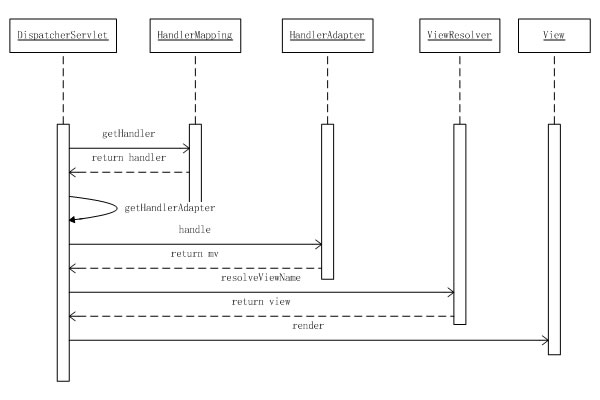您好,登錄后才能下訂單哦!
您好,登錄后才能下訂單哦!
前端控制器是整個MVC框架中最為核心的一塊,它主要用來攔截符合要求的外部請求,并把請求分發到不同的控制器去處理,根據控制器處理后的結果,生成相應的響應發送到客戶端。前端控制器既可以使用Filter實現(Struts2采用這種方式),也可以使用Servlet來實現(spring MVC框架)。

DispatcherServlet 作為前置控制器是web服務器的入口,是spring mvc最重要的一個類,通過它的生命周期可以加深對web服務器的理解。
servlet的生命周期
首先我們回憶一下servlet的生命周期:
Servlet生命周期分為三個階段:【Servlet生命周期與工作原理詳解】
1.初始化階段 調用init()方法。Servlet被裝載后,Servlet容器創建一個Servlet實例并且調用Servlet的init()方法進行初始化。在Servlet的整個生命周期內,init()方法只被調用一次。
2.響應客戶請求階段 調用service()方法
3.終止階段 調用destroy()方法
Servlet初始化階段
在下列時刻Servlet容器裝載Servlet:
1.Servlet容器啟動時自動裝載某些Servlet,實現它只需要在web.XML文件中的<Servlet></Servlet>之間添加如下代碼:
<loadon-startup>1</loadon-startup>
2.在Servlet容器啟動后,客戶首次向Servlet發送請求
3.Servlet類文件被更新后,重新裝載Servlet
DispatcherServlet的結構
復習了上述知識后我們來看看DispatcherServlet的結構:
DispatcherServlet繼承自抽象類:FrameworkServlet,間接繼承了HttpServlet (FrameworkServlet繼承自HttpServletBean,而HttpServletBean繼承自HttpServlet )
Servlet的初始化

protected void initStrategies(ApplicationContext context) {
initMultipartResolver(context); //文件上傳解析,如果請求類型是multipart將通過MultipartResolver進行文件上傳解析;
initLocaleResolver(context); //本地化解析
initThemeResolver(context); //主題解析
initHandlerMappings(context); //通過HandlerMapping,將請求映射到處理器
initHandlerAdapters(context); //通過HandlerAdapter支持多種類型的處理器
initHandlerExceptionResolvers(context); //如果執行過程中遇到異常將交給HandlerExceptionResolver來解析
initRequestToViewNameTranslator(context); //直接解析請求到視圖名
initViewResolvers(context); //通過ViewResolver解析邏輯視圖名到具體視圖實現
initFlashMapManager(context); //flash映射管理器
}
servlet如何處理請求:
servlet的service方法處理http請求。
FrameworkServlet.java 定義了servlet的service和destroy方法,如下所示:
/**
* Override the parent class implementation in order to intercept PATCH
* requests.
*/
@Override
protected void service(HttpServletRequest request, HttpServletResponse response)
throws ServletException, IOException {
String method = request.getMethod();
if (method.equalsIgnoreCase(RequestMethod.PATCH.name())) {
processRequest(request, response);
}
else {
super.service(request, response);
}
}
我們知道http請求類型有七種(外加一個option選項),定義如下:
public enum RequestMethod {
GET, HEAD, POST, PUT, PATCH, DELETE, OPTIONS, TRACE
}
FrameworkServlet的service()處理不同的請求,我們以常見的post來說明:
/**
* Process this request, publishing an event regardless of the outcome.
* <p>The actual event handling is performed by the abstract
* {@link #doService} template method.
*/
protected final void processRequest(HttpServletRequest request, HttpServletResponse response)
throws ServletException, IOException {
long startTime = System.currentTimeMillis();
Throwable failureCause = null;
LocaleContext previousLocaleContext = LocaleContextHolder.getLocaleContext();
LocaleContext localeContext = buildLocaleContext(request);
RequestAttributes previousAttributes = RequestContextHolder.getRequestAttributes();
ServletRequestAttributes requestAttributes = buildRequestAttributes(request, response, previousAttributes);
WebAsyncManager asyncManager = WebAsyncUtils.getAsyncManager(request);
asyncManager.registerCallableInterceptor(FrameworkServlet.class.getName(), new RequestBindingInterceptor());
initContextHolders(request, localeContext, requestAttributes);
try {
doService(request, response);
}
catch (ServletException ex) {
failureCause = ex;
throw ex;
}
catch (IOException ex) {
failureCause = ex;
throw ex;
}
catch (Throwable ex) {
failureCause = ex;
throw new NestedServletException("Request processing failed", ex);
}
finally {
resetContextHolders(request, previousLocaleContext, previousAttributes);
if (requestAttributes != null) {
requestAttributes.requestCompleted();
}
if (logger.isDebugEnabled()) {
if (failureCause != null) {
this.logger.debug("Could not complete request", failureCause);
}
else {
if (asyncManager.isConcurrentHandlingStarted()) {
logger.debug("Leaving response open for concurrent processing");
}
else {
this.logger.debug("Successfully completed request");
}
}
}
publishRequestHandledEvent(request, startTime, failureCause);
}
}
FrameworkServlet 抽象定義了處理流程,留待子類來實現該方法,完成具體的請求處理。
/**
* Subclasses must implement this method to do the work of request handling,
* receiving a centralized callback for GET, POST, PUT and DELETE.
* <p>The contract is essentially the same as that for the commonly overridden
* {@code doGet} or {@code doPost} methods of HttpServlet.
* <p>This class intercepts calls to ensure that exception handling and
* event publication takes place.
* @param request current HTTP request
* @param response current HTTP response
* @throws Exception in case of any kind of processing failure
* @see javax.servlet.http.HttpServlet#doGet
* @see javax.servlet.http.HttpServlet#doPost
*/
protected abstract void doService(HttpServletRequest request, HttpServletResponse response)
throws Exception;
具體實現如下:
/**
* Exposes the DispatcherServlet-specific request attributes and delegates to {@link #doDispatch}
* for the actual dispatching.
*/
@Override
protected void doService(HttpServletRequest request, HttpServletResponse response) throws Exception {
if (logger.isDebugEnabled()) {
String resumed = WebAsyncUtils.getAsyncManager(request).hasConcurrentResult() ? " resumed" : "";
logger.debug("DispatcherServlet with name '" + getServletName() + "'" + resumed +
" processing " + request.getMethod() + " request for [" + getRequestUri(request) + "]");
}
// Keep a snapshot of the request attributes in case of an include,
// to be able to restore the original attributes after the include.
Map<String, Object> attributesSnapshot = null;
if (WebUtils.isIncludeRequest(request)) {
attributesSnapshot = new HashMap<String, Object>();
Enumeration<?> attrNames = request.getAttributeNames();
while (attrNames.hasMoreElements()) {
String attrName = (String) attrNames.nextElement();
if (this.cleanupAfterInclude || attrName.startsWith("org.springframework.web.servlet")) {
attributesSnapshot.put(attrName, request.getAttribute(attrName));
}
}
}
// Make framework objects available to handlers and view objects.
request.setAttribute(WEB_APPLICATION_CONTEXT_ATTRIBUTE, getWebApplicationContext());
request.setAttribute(LOCALE_RESOLVER_ATTRIBUTE, this.localeResolver);
request.setAttribute(THEME_RESOLVER_ATTRIBUTE, this.themeResolver);
request.setAttribute(THEME_SOURCE_ATTRIBUTE, getThemeSource());
FlashMap inputFlashMap = this.flashMapManager.retrieveAndUpdate(request, response);
if (inputFlashMap != null) {
request.setAttribute(INPUT_FLASH_MAP_ATTRIBUTE, Collections.unmodifiableMap(inputFlashMap));
}
request.setAttribute(OUTPUT_FLASH_MAP_ATTRIBUTE, new FlashMap());
request.setAttribute(FLASH_MAP_MANAGER_ATTRIBUTE, this.flashMapManager);
try {
doDispatch(request, response);
}
finally {
if (WebAsyncUtils.getAsyncManager(request).isConcurrentHandlingStarted()) {
return;
}
// Restore the original attribute snapshot, in case of an include.
if (attributesSnapshot != null) {
restoreAttributesAfterInclude(request, attributesSnapshot);
}
}
}
重頭戲,作為請求分發器的實現:
功能:1. 把請求分發到handler(按照配置順序獲取servlet的映射關系獲取handler);2. 根據servlet已安裝的 HandlerAdapters 去查詢第一個能處理的handler;3. handler激發處理請求
/**
* Process the actual dispatching to the handler.
* <p>The handler will be obtained by applying the servlet's HandlerMappings in order.
* The HandlerAdapter will be obtained by querying the servlet's installed HandlerAdapters
* to find the first that supports the handler class.
* <p>All HTTP methods are handled by this method. It's up to HandlerAdapters or handlers
* themselves to decide which methods are acceptable.
* @param request current HTTP request
* @param response current HTTP response
* @throws Exception in case of any kind of processing failure
*/
protected void doDispatch(HttpServletRequest request, HttpServletResponse response) throws Exception {
HttpServletRequest processedRequest = request;
HandlerExecutionChain mappedHandler = null;
boolean multipartRequestParsed = false;
WebAsyncManager asyncManager = WebAsyncUtils.getAsyncManager(request);
try {
ModelAndView mv = null;
Exception dispatchException = null;
try {
processedRequest = checkMultipart(request);
multipartRequestParsed = (processedRequest != request);
// Determine handler for the current request.
mappedHandler = getHandler(processedRequest);
if (mappedHandler == null || mappedHandler.getHandler() == null) {
noHandlerFound(processedRequest, response);
return;
}
// Determine handler adapter for the current request.
HandlerAdapter ha = getHandlerAdapter(mappedHandler.getHandler());
// Process last-modified header, if supported by the handler.
String method = request.getMethod();
boolean isGet = "GET".equals(method);
if (isGet || "HEAD".equals(method)) {
long lastModified = ha.getLastModified(request, mappedHandler.getHandler());
if (logger.isDebugEnabled()) {
logger.debug("Last-Modified value for [" + getRequestUri(request) + "] is: " + lastModified);
}
if (new ServletWebRequest(request, response).checkNotModified(lastModified) && isGet) {
return;
}
}
if (!mappedHandler.applyPreHandle(processedRequest, response)) {
return;
}
try {
// Actually invoke the handler.
mv = ha.handle(processedRequest, response, mappedHandler.getHandler());
}
finally {
if (asyncManager.isConcurrentHandlingStarted()) {
return;
}
}
applyDefaultViewName(request, mv);
mappedHandler.applyPostHandle(processedRequest, response, mv);
}
catch (Exception ex) {
dispatchException = ex;
}
processDispatchResult(processedRequest, response, mappedHandler, mv, dispatchException);
}
catch (Exception ex) {
triggerAfterCompletion(processedRequest, response, mappedHandler, ex);
}
catch (Error err) {
triggerAfterCompletionWithError(processedRequest, response, mappedHandler, err);
}
finally {
if (asyncManager.isConcurrentHandlingStarted()) {
// Instead of postHandle and afterCompletion
mappedHandler.applyAfterConcurrentHandlingStarted(processedRequest, response);
return;
}
// Clean up any resources used by a multipart request.
if (multipartRequestParsed) {
cleanupMultipart(processedRequest);
}
}
}
servlet銷毀
/**
* Close the WebApplicationContext of this servlet.
* @see org.springframework.context.ConfigurableApplicationContext#close()
*/
@Override
public void destroy() {
getServletContext().log("Destroying Spring FrameworkServlet '" + getServletName() + "'");
// Only call close() on WebApplicationContext if locally managed...
if (this.webApplicationContext instanceof ConfigurableApplicationContext && !this.webApplicationContextInjected) {
((ConfigurableApplicationContext) this.webApplicationContext).close();
}
}
小結:
本文因篇章限制,僅僅介紹了請求處理的流程,沒有對代碼進行深入的分析,接下來的文章將從細微處著手,分析spring的代碼之美。
以上就是本文的全部內容,希望對大家的學習有所幫助,也希望大家多多支持億速云。
免責聲明:本站發布的內容(圖片、視頻和文字)以原創、轉載和分享為主,文章觀點不代表本網站立場,如果涉及侵權請聯系站長郵箱:is@yisu.com進行舉報,并提供相關證據,一經查實,將立刻刪除涉嫌侵權內容。